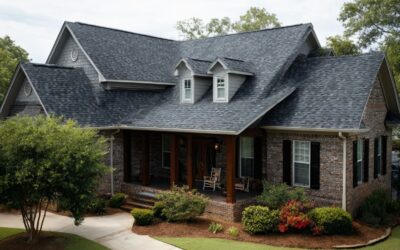Tile roofs are known for their beauty, durability, and long lifespan, making them a popular choice for homeowners looking for a long-term roofing solution. But how long do tile roofs last? The answer depends on several factors, including the type of tile, installation quality, and maintenance.
At Heaven Sent Roofing, we specialize in high-quality tile roofing for homes and businesses. In this guide, we’ll explore the lifespan of tile roofs, what affects their longevity, and how you can extend the life of your tile roof for decades to come.
What Is the Lifespan of a Tile Roof?
The lifespan of a tile roof varies based on the material used. Here’s a breakdown of how long different types of tile roofs last:
- Clay Tile Roofs: 50 to 100 years
- Concrete Tile Roofs: 40 to 75 years
- Slate Tile Roofs: 75 to 150 years
Compared to asphalt shingles, which typically last 20-30 years, tile roofing provides exceptional longevity and value.
Many historic buildings still have clay or slate tile roofs that have lasted over a century, proving that tile roofing is one of the most durable roofing options available.
Factors That Affect the Longevity of Tile Roofs
1. Quality of Installation
A tile roof’s lifespan depends heavily on proper installation. A poorly installed roof can develop leaks and structural issues early on. Hiring an experienced roofing company like Heaven Sent Roofing ensures your tile roof is installed correctly for maximum durability.
2. Climate and Weather Conditions
Tile roofs perform well in various climates, but extreme weather can impact their lifespan:
- Hot Climates: Clay tiles reflect heat, making them ideal for warm regions like Florida.
- Hurricane-Prone Areas: Properly installed tile roofs can withstand high winds, but broken tiles should be replaced promptly.
- Cold Climates: Freeze-thaw cycles can cause cracks in certain types of tiles if they are not designed for cold weather.
3. Regular Maintenance
Routine maintenance plays a critical role in extending the life of a tile roof. Homeowners should:
- Inspect the roof for broken or missing tiles annually.
- Keep gutters and valleys clear of debris to prevent water buildup.
- Check for mold or algae growth, especially in humid environments.
The National Roofing Contractors Association (NRCA) recommends regular roof inspections to catch minor issues before they become major problems. Read more about proper roof maintenance from the NRCA.
Benefits of Choosing a Tile Roof
1. Exceptional Durability
Tile roofing is one of the strongest roofing materials available. Unlike asphalt shingles, which deteriorate over time, tile roofs resist harsh weather, fire, and insect damage.
2. Energy Efficiency
Tile roofs help regulate indoor temperatures, keeping homes cooler in the summer and warmer in the winter. This reduces energy bills and makes tile roofing an eco-friendly choice.
3. Low Maintenance
Once installed, tile roofs require minimal maintenance compared to other roofing materials. Regular inspections and minor repairs help ensure they last for decades.
4. Increased Property Value
A tile roof adds curb appeal and long-term value to a home. Buyers often prefer homes with durable roofing materials, making tile roofing a smart investment.

How to Extend the Life of Your Tile Roof
1. Schedule Professional Inspections
Hiring a professional roofer for an annual inspection helps identify potential issues before they cause major damage.
2. Replace Broken or Cracked Tiles
Cracked tiles can allow water to seep into the underlayment, leading to leaks and structural damage. Replacing damaged tiles promptly can prevent costly repairs.
3. Keep the Roof Clean
Moss, algae, and debris can trap moisture, leading to premature wear. Regular cleaning helps maintain the roof’s integrity and appearance.
For expert guidance on roof care and longevity, check out the U.S. Department of Energy’s roofing guide.
Are Tile Roofs Worth the Investment?
Tile roofs have a higher upfront cost than asphalt shingles, but their longevity and low maintenance requirements make them a cost-effective choice in the long run.
Here’s how tile roofing compares to other materials:
| Roofing Material | Average Lifespan | Maintenance Needs |
| Asphalt Shingles | 20-30 years | High |
| Metal Roofing | 40-70 years | Low |
| Tile Roofing | 50-100+ years | Low |
If you plan to stay in your home for decades, a tile roof offers unmatched durability and savings on repairs and replacements.
Signs Your Tile Roof Needs Repairs or Replacement
Even the most durable tile roofs require occasional repairs. Look out for these warning signs:
- Missing or broken tiles
- Water stains on ceilings or walls
- Mold or algae growth
- Sagging roof sections
- Cracked underlayment
Ignoring these issues can lead to bigger problems, such as leaks or structural damage. If you notice any of these signs, schedule a professional inspection to protect your investment.
Upgrade to a Long-Lasting Tile Roof Today!
So, how long do tile roofs last? With proper installation and maintenance, they can protect your home for 50 to 100+ years. Whether you’re looking to install a new tile roof or need repairs, Heaven Sent Roofing is here to help.
Get expert advice and get a free estimate now for your tile roofing project. Invest in a roof that stands the test of time!



